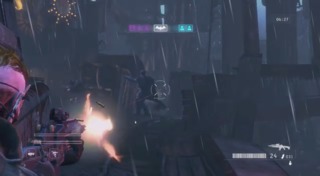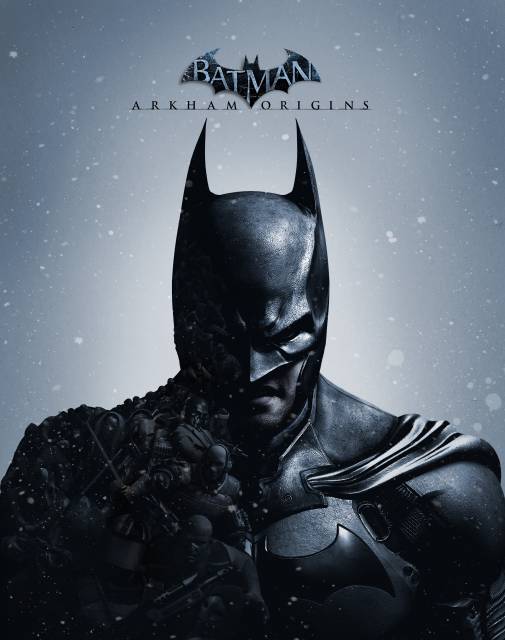From the Shadows

As far as I’m concerned the Batman: Arkham games are a manual on how to adapt a work into video game form. To nail the tone and atmosphere of Batman’s modern gothic world and to achieve such success in redrawing the series’ classic heroes and villains would be one thing, but what made Arkham Asylum and Arkham City the masterpieces they were was being able to mould gameplay mechanics which made you genuinely feel like Batman, especially because the gameplay actions were both easy to perform the fundamentals of, and incredibly empowering when used successfully. With the series’ development baton being temporarily passed from Rocksteady Studios to Warner Bros. Montreal there was understandable worry that the franchises’ new guardians would not be able to recreate that same magic. Fortunately Montreal had little trouble in that department, but as this final product shows perhaps we should not just have been concerned with whether they were going to be able to replicate what came before, but also whether they could make any meaningful additions to the series themselves.
Origins drops you somewhere in the pre-Asylum region of the Arkham timeline, where a younger and more foolhardy Bruce Wayne has adopted the persona of the Batman, but is still establishing himself as a presence in the city. On the night of Christmas Eve he stops a violent breakout at Blackgate Prison and in the process learns that there are eight elite assassins who have been hired to kill him. Against the advice of his ever-loyal butler Alfred Pennyworth, he steals away into the night to halt the festive crime wave on the horizon and bring his would-be murderers to justice.
The best of what this game delivers is what it takes from the previous two Batman games, and you almost wouldn’t know the base combat, stealth, and puzzle mechanics weren’t engineered by Rocksteady. There are more notable bad things to say about the game than good, but that’s partly because if you’ve played the Arkham games before you already know what’s coming, and you already know how thrilling all of this is; the fluidity of the traversal and combat encounters, the sense of power as you pick off cowering enemies one-by-one from the shadows, and the way the puzzles make you feel like a master of deduction. It’s arguable that Batman handles in a slightly stiffer manner than in previous games, but by and large what you come to an Arkham game for is alive and well in Origins.

As for what Montreal bring to the table, one of my favourite additions is the new soundtrack, the biggest standout piece from which may be the Carol of the Bells which adds a haunting and appropriate backdrop for the chilling events of the story. More broadly, the OST attempts to bring the music of the Arkham games more in-line with the soundtracks of Christopher Nolan’s Batman films. It gives the game a bracing excitement, but it’s also indicative of the design decisions made in Origins as a whole. Warner Montreal add their own touches to the Arkham blueprint here and there, and they make a cool game out of what they’re given, but they feel too afraid of rocking the boat to leave any lasting mark on the series. Batman is a story of darkness and danger, and yet this feels all too safe.
Most of the new gadgets come down dead centre between being fun to deploy and derivative of existing equipment. The game does at least make an intelligent choice by introducing some of the more advanced gadgets and enemies from previous games earlier on this time round, keeping you from retreading too much old territory, but take the Remote Claw. It allows you to link two points using a line you can zip down or perch on and can be whipped out in combat to send nearby objects flying into enemies. This is exactly as gratifying as it sounds, yet the gadget is an obvious variation on the old Line Launcher. The Concussion Grenade can confuse enemies into attacking each other, but primarily it just stuns them, like the Batarang. The Glue Grenade can stick enemies together for a limited time, but it’s basically an immobilising weapon which creates ad hoc rafts when thrown into water, just like the Freeze Grenade, and so on. Enemy types are created and rolled out with a similar mindset.
There’s a new foe that requires you to stun them three times before attacking which is okay, and a new enemy which must be countered twice to attack back against which I genuinely like, but they could both stand to be used a little more and they don’t make you pursue truly new fighting techniques, they just make you use variants of existing ones. The biggest significant alteration to the combat is a piece of equipment you gain towards the back half of the game which lets you ignore enemies’ regular defences like shields and stun batons for a limited time. This power-up is a mixed blessing, giving you a feeling of force and freedom as you can indiscriminatory punch your way around an arena, but simultaneously meaning that combat requires less skill and variation, which is a big loss.

Beyond the fighting and puzzle-solving, Arkham Origins opens up an entirely new branch of gameplay. Batman may be a fighter and a techhead, but he’s also “The World’s Greatest Detective”, and the game attempts to bring this dimension of his character into the fold. At various points in the game you can investigate crime scenes and put clues together to watch virtual computerised recreations of shootings, bombings, and other acts of villainy. The problem is while these reconstructions come with plenty of flash and cool cyberfetishism, most “investigation” involves moving between indicated areas and holding down A to scan evidence, or occasionally using the triggers to rewind and fast-forward events, looking for more objects you can hold A near. Unlike the gameplay in previous Arkham games which felt like a reasonably realistic approximation of Batman’s activities, these mechanics don’t make you feel like you are Batman. It feels like you’re a camera operator who moves from A to B while Batman exists as a separate person from you and handles all the truly interesting parts of the scenes himself, like working out what the clues mean and explaining how they fit together.
In general the game feels held back by its yearning to be more “cinematic”. It will sometimes implement cutscenes for moments that feel like they should have been gameplay-driven, and considering this is the Arkham most reliant on pre-rendered cutscenes so far, the technical quality of them is below par. A lot of effort has obviously gone into creating detailed renders of characters, objects, and places, and yet these sequences frequently appear blurry, poorly lit, and overly compressed. The story is not what you’d expect of a Batman origin tale either. On the plus side Troy Baker takes on the role of the Joker from Mark Hamill admirably, revelling in his carefree psychosis, and the game plays it right by starting things after Wayne has put together the Batman alter-ego, saving us from the predictable Batman origin story we’ve seen so many times before. There are also some engrossing character moments around the half to two-thirds mark as Batman faces up to the consequences of his actions and we get to explore the psychology of one particular character a little more deeply. However, for various different reasons, many crucial story moments fall flat.
For example, it’s more than once implied that Batman has deep-seated regret over failing to save the life of a civilian near the beginning of the game, but the character involved is a complete stranger to Batman and zero is done to give us any kind of background to or empathy for her beforehand. The subtitles literally just refer to her as “Bank Lady”. One plot twist reveals a certain character to be involved in an important story event unbeknownst to us and Batman before that moment, but as almost nothing was done to establish the character up until that reveal, it feels hard to care. Early on in the game I also began to wonder whether Batman wasn’t losing his mind a little, keeping up a running internal monologue about which gadget he should use where to overcome which challenges, and a certain amount of the time it feels like the game is just flatly and mindlessly churning out plot and dialogue without injecting any passion into it. The single-player mode culminates in a section where the framerate dips low enough to become a barrier to fighting enemies, and at the end you are ultimately deprived of the big gameplay climax you’d been waiting for.

In addition to the single-player mode there is also a multiplayer component of the game which feels inspired in theory, yet janky and alienating in practise. Play involves three teams: Bane’s Gang, Joker’s Gang, and Batman and Robin. The two gangs remain locked in a third-person shootout where in addition to standard weaponry they can also make use of a version of Detective Vision that works for a limited time and special equipment like UAVs and missiles. Each gang’s objective involves killing members of the opposing gang and/or capturing control points on the map. Meanwhile, Batman and Robin skulk around the map, equipped with the same moveset from the single-player mode and a few gadgets like the Explosive Batarang and the Detective Vision Jammer. Their goal is to strike down enemies to fuel an “Intimidation Meter”, attempting to completely fill it before either gang can finish their objective. While Batman and Robin can attack faster and with less warning than the gang members, their power is offset by a number of disadvantages such as their longer respawn timer and low health.
You can imagine the mode being an okay third-person shooter or a solid Batman and Robin co-op experience, but it’s when the two ideas combine that it all falls apart. If you’re a henchmen you’re best served by boring memorisation of all the vantage points on the map, and if you fail that the Batman team’s stealth abilities mean that you can be taken down out of nowhere without a chance to fight back. If you are Batman or Robin then players being able to move quickly, avoid your hiding places, and see if you’re sneaking up behind them means that a lot of the stealth takedowns which are some of the most fulfilling parts of the single-player are no longer an option, and you must resort to less elegant and less functional methods to deal with opposing teams.
As the Batman team most of the sense of flow and grace from the single-player vanishes into thin air. The Glide Kick is a good example of this. In the main story mode this is a way to swoop down over enemies and start a fight by delivering a painful but precise blow. In the multiplayer, because enemies can run from your Glide Kick, they can dodge out the way of you entirely and drag you a little way across the map. Perhaps in the time it took you to perform your Glide Kick more enemies even showed up unpredictably to gun you down, or say you do hit your target, it’s likely they’ve now gone flying a short distance so you have to awkwardly reposition yourself to get a Ground Takedown. During this takedown Batman and Robin typically twitch about and stutter as they struggle to align themselves with their target before delivering the final punch. Whenever you’re not attacking your Intimidate Meter drains, resulting in the game effectively punishing the patience that’s typically required for a good stealth attack. What’s more, being able to take significantly less bullets than the average street hooligan does little to convince you that you’re a tough-as-nails crimefighter.
To its credit the shooting is fine and if you’re a street thug you can sometimes get to play as The Joker or Bane which is exciting. Using your teammate or other enemies as a distraction while playing a good guy even has its upsides, but the mode is less than the sum of its parts. If you want the experience of being Batman and eliminating henchmen with power and finesse then you’re better off playing the single-player. If you want a multiplayer Batman third-person shooter where you’re not a big hero or villain but take up a more humble character role, you’d probably prefer Gotham City Imposters. Oh, and yes, to add insult there is a microtransaction system which lets other players get an advantage over you by giving Warner Bros. more money.
When all is said and done Batman: Arkham Origins falls into a category that a sadly increasing number of big name games are filling: The AAA sequel that’s enjoyable, but disappointing because it’s too scared of doing new things. If you’ve played what the series has to offer so far and are craving more time under the cowl there’s plenty of fun to be had with Origins, but its multiplayer mode is uncomfortable in its own skin and the single-player has not been built with the same ambition of its predecessors.
